
DDFAQs or the Start of Everything You Need to Know about How to End the World in 2020
With the influx of new interest towards the archetype, there has been a rise in new players gravitating towards our favourite sorcery. With this surge in new blood there have been a number of questions that keep cropping up for people either interested, or starting off playing Doomsday. I had hoped to at least start answering many of the questions in my first article, which you should really have a read of before going through this one, however it seems I didn't touch on many points so hopefully this should provide some clarity on the following things:
The Different Doomsday Archetypes
Although it wasn't always the case, it seems currently the most popular medium for discussing specific Legacy archetypes (at the time of writing) is via dedicated Discord servers for each archetype. The Doomsday community is no exception to this and though it may seem like a very aggressive and somewhat shameless plug so early on in this article, there is a purpose to this.
Until recently we had one primary discussion channel for Legacy Doomsday with no real regard for the different variants however with so many people joining the server for one specific variant or another, we had to do a little tidy up. Part of this process included listing the variants out so that people could read a summary of each and select the one/(s) they liked the sound of to have access to those select parts of the server. Despite these summaries being present we still get some confusion as to what the differences actually entail both in terms of deck building decisions and in terms of personal preferences or gameplay styles.
I will present the three main variants below with the current Discord summary and a bit more comparison on each.
DDFT (DoomsDay Fetchland Tendrils)
Lists that utilise traditional elements such as Burning Wish, some sort of draw 3/4 engine and focus on a Storm style approach to winning (however do not always require storm to win).
As mentioned last time, DDFT is the traditional name of historical iterations of the deck. We won't do a full history lesson here however it basically refers to the fact that this is a storm deck that can play a much longer game if required.
The deck normally incorporates some sort of raw card advantage engine such as Ideas Unbound, Act on Impulse, Three Wishes or Cruel Bargain to enable drawing into the Doomsday pile. Burning Wish has been used often to enable additional pseudo copies of Doomsday and newer cards like Echo of Eons have been incorporated in lists too. The aim of the deck is to kill via a Doomsday pile with lethal Tendrils of Agony or Thassa's Oracle or a natural Tendrils storm kill without Doomsday. See an example pile below:

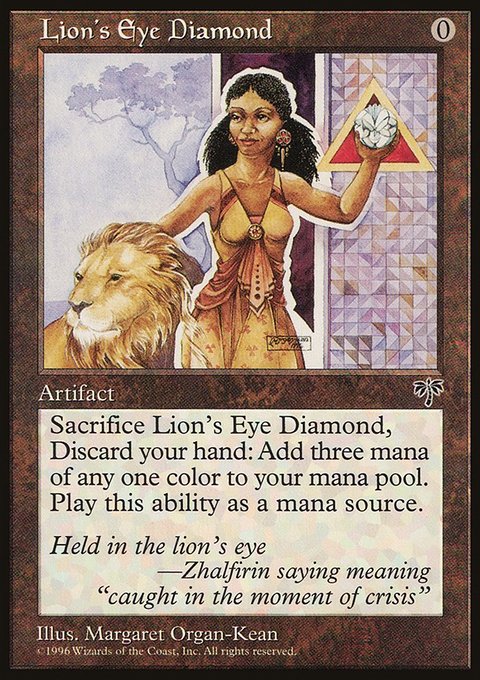

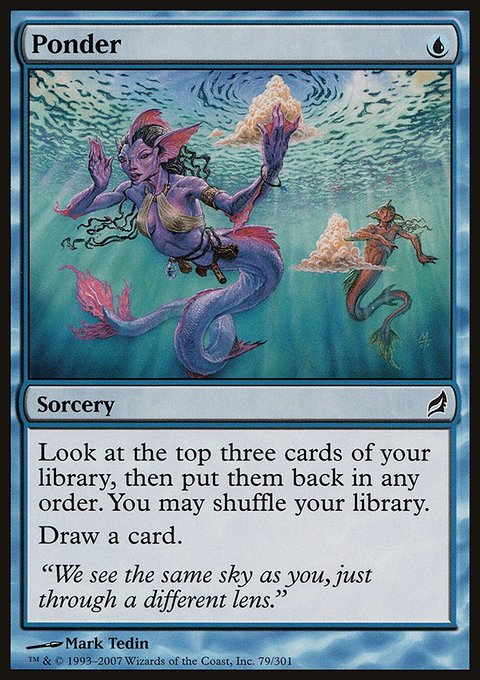
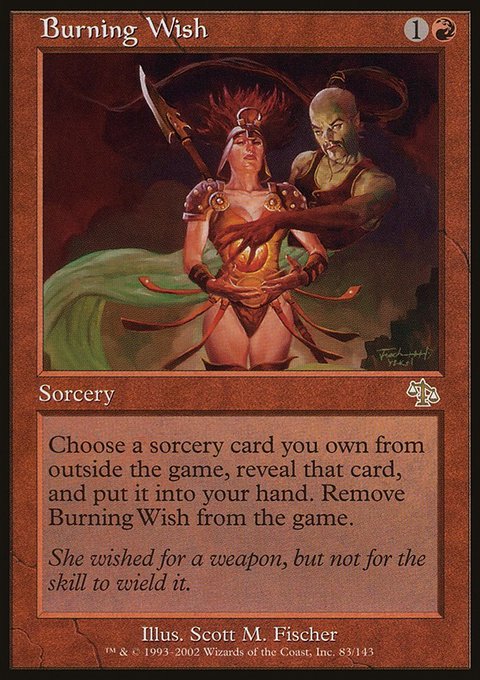
Due to the cards used, the deck tends to be Grixis colours sometimes splashing Green for sideboard options.
DDEFT (DoomsDay Experimental Frenzy Tendrils)
Lists that utilise Experimental Frenzy as the primary engine to win.
The summary defines this sub-archetype pretty well. Experimental Frenzy is a very powerful card advantage engine that can, under the right circumstances, allow you to transform your entire deck into a Doomsday pile. If you cast a Doomsday with Frenzy active, you have a deterministic kill that can get through infinite life should you wish. The deck can pull off the same win methods as DDFT but also allows winning via infinite copies of Collective Brutality amongst other things (see example below).



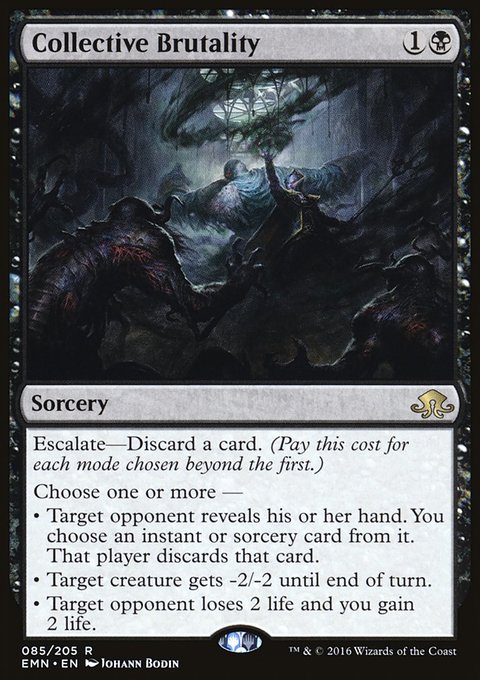
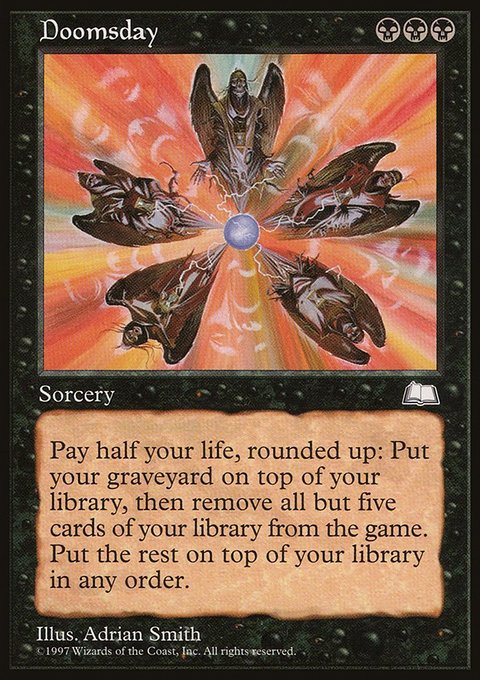
Instead of using Burning Wish for additional copies of Doomsday, the deck uses cards like Lim-Dûl's Vault to act as tutor pieces prior to going off and facilitate the kill from an active Frenzy (as they let you stack the top of the deck you are playing from).
Due to the cards used, this deck also tends to be Grixis colours sometimes splashing Green for sideboard options.
Meandeck Doomsday
Lists that are less combo focused and incorporate reactive countermagic such as Force of Will within their game plan.
Meandeck Doomsday tends to play a slower gameplan than the other two variants focussing more on controlling the game prior to going off. The deck is more prone to passing the turn after resolving a Doomsday whereas DDFT and DDEFT are both more designed to go off the same turn you resolve one. This version plays less dedicated combo pieces such as Lion's Eye Diamond and more reactive control elements like Force of Will. The deck does not run Storm based win conditions either. An example pile is below:
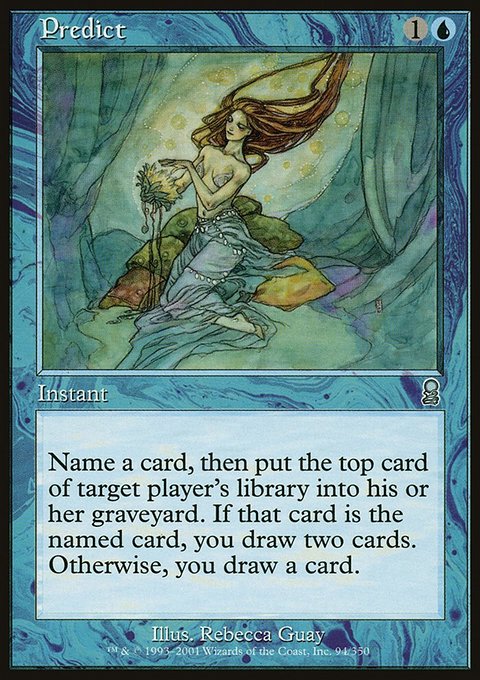

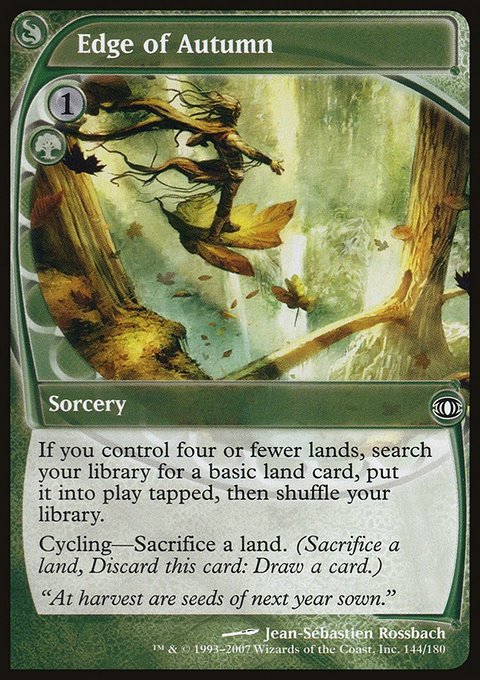

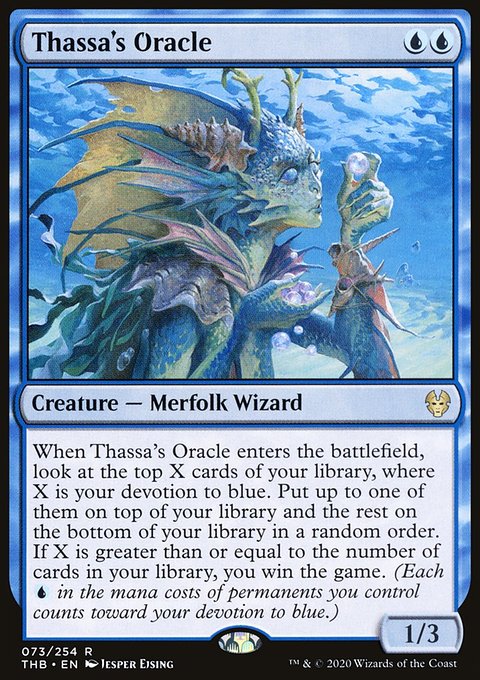
Note: At the time of writing this article, this variant is the one having most success in tournaments.
Card Choices
One thing newer players always ask is "what is the standard list being played". This is a difficult question to answer due to the flexibility of the deck to incorporate different cards and play different strategies/elements. Pilot preference can also feature heavily meaning where one person may be having success with one style of list, another person might be doing the same with a completely different style.
A good example of this is the Legacy 5-0 league results posting from 21/03/2020 (03/21/2020 for any US folk) which featured two Doomsday pilots, each playing a Meandeck variant. This shows how different lists can be playing to same archetype.
This section will go into a breakdown of card choices for a Doomsday deck and some of the thought processes behind them. The discussion will touch upon considerations for all three variants as there are common factors between them.
Doomsday
Now it seems a bit superfluous to mention but the first part, and the main link between the variants, is the namesake card itself; Doomsday. No matter what variant you are playing, you will be wanting to run 4 of these no matter what. With Meandeck and DDEFT variants these will often just all be run in the main however thanks to Burning Wish, DDFT variants may run three in the main and on in the sideboard as a wish target thereby increasing the number of pseudo copies in the deck up to 7 (3 DD, 4 BW).
There are a number of other cards that can also fall into this category alongside Burning Wish as cards that are basically designed to find Doomsday to win. These include, but are not limited to, the aforementioned Burning Wish, Lim-Dûl's Vault and Wishclaw Talisman. They are mostly there to increase your Doomsday count beyond 4 as it is normally the card that needs to resolve to enable you to win the game. Experimental Frenzy also falls under this category as it generally counts as a card that will normally win you the game if it resolves.
A deck generally wants to have between 4 and 8 primary bombs. Any less and you are likely to not find your game winning spell, any more and you can often be flooded with redundant copies.

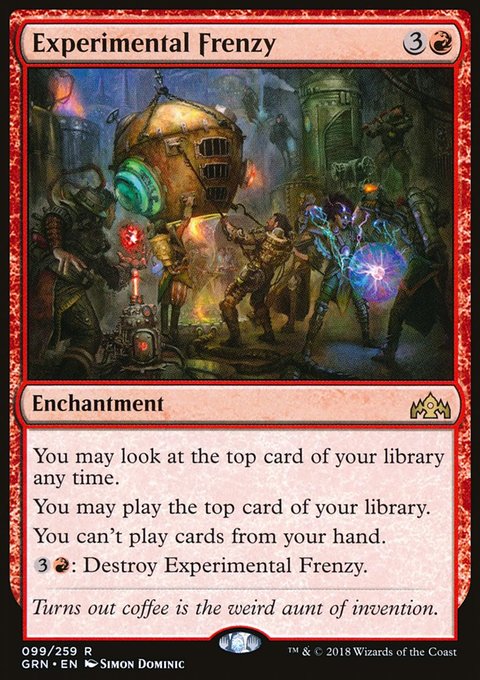
Mana Acceleration and Fixing
As the primary win condition for the deck is a 3 mana card, this can be quite a struggle to get to in a format like Legacy where resource efficiency is prized above all else. With cards like Thalia, Guardian of Thraden in the format, it is important to be able to resolve your game winning card fast to prevent your opponents from dropping hate elements or simply to outrace your opponent to prevent them winning the game first. To facilitate this, a number of mana acceleration options are used.
The deck normally plays out like a mono deck to begin with, cast cantrips and setting up but then needs to pivot into almost a mono deck to win. Going from a Wasteland proof manabase to something that produces can be tricky without fixing so along with acceleration elements, fixing elements are also incorporated.
Cards like Dark Ritual and Lotus Petal allow you to get ahead of mana quickly and can help fix your colours to provide the needed to cast Doomsday. These are the main mana enablers that can be found across all variants. Dark Ritual especially allows you to cast Doomsday off of a single B source which is great against mana denial strategies many decks deploy.
It wouldn't be a post-2019 article without mentioning Arcum's Astrolabe. By manipulating the manabase so it includes a heavy Snow-Covered basic count you can include this efficient Prophetic Prism that enables mana fixing and does not lose card advantage whilst playing it.
You may note I have not yet discussed Lion's Eye Diamond here, this will be covered in Combo Pieces.
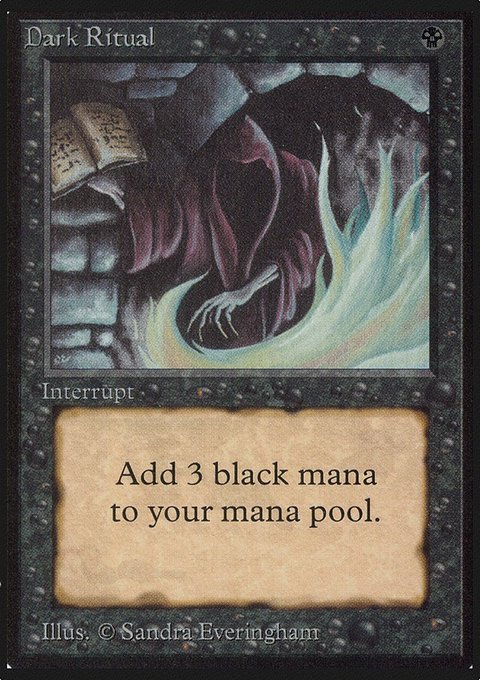
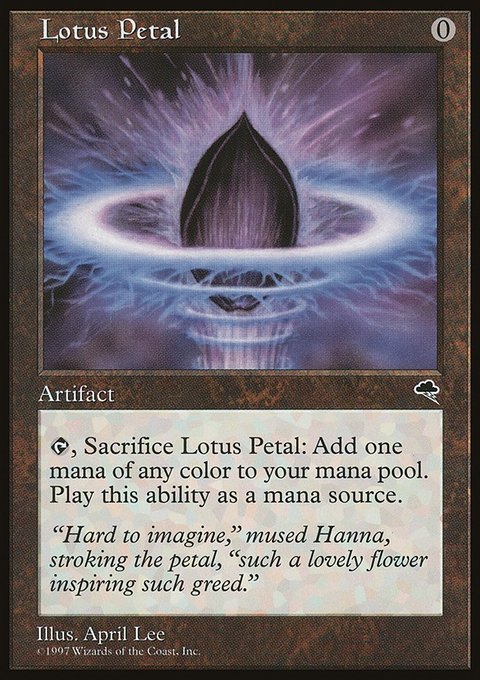
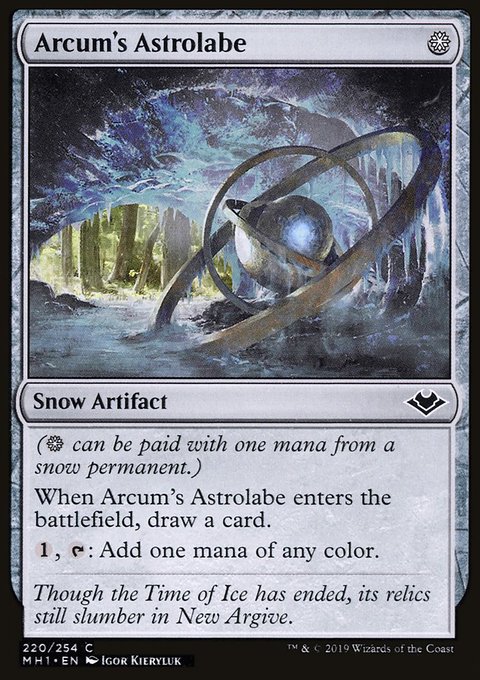
DDFT and DDEFT
For these variants both Dark Ritual and Lotus Petal should be considered as 4-ofs. In addition some consideration might be given to running additional acceleration in the form of up to 1 Cabal Ritual or Rain of Filth. These variants want to go fast and as such, the levels of fast mana should be increased to facilitate this. Conversely, these decks most likely do not want to run Astrolabe as it promotes a slower gameplay style overall but can still reasonably incorporate it if desired.
Meandeck
Meandeck lists are less concerned with going fast. They still want to run between 3-4 Rituals as it enables the more mana efficient kill turns however they likely only want between 1-3 Petals, normally around 2 at most. This is the variant that most favours the Astrolabe fixing plan being able to drop basics at a steady rate and favouring resilience over speed within the gameplan. If you are running Astrolabe it should be between 2-4 however higher numbers are recommended.
Cantrips
Cantrips are a staple of almost any Legacy deck that runs and this one is no exception. Just like other combo variants, Doomsday wants to find the pieces it needs as quickly and reliably as it can so it tends to have a greater number of cantrips relative to other fairer decks. Unlike other combo decks like TES however, the cantrips can actually form an integral part of the combo itself and so ensuring these are at a maximum is key. You don't want to be having to burn through cantrips to find pieces to then find yourself unable to draw into an otherwise game-winning pile.
As a result I would expect any Doomsday deck to be running Brainstorm, Ponder and Preordain in various ratios of 4-4-X. In addition to this some lists will be running the previously cited Arcum's Astrolabe along with some spicier elements such as Street Wraith and Edge of Autumn however more on those later. Combine these with some of the cantripping protection elements and more niche combo cards like Conjurer's Bauble you should end up with a very high cantrip number.

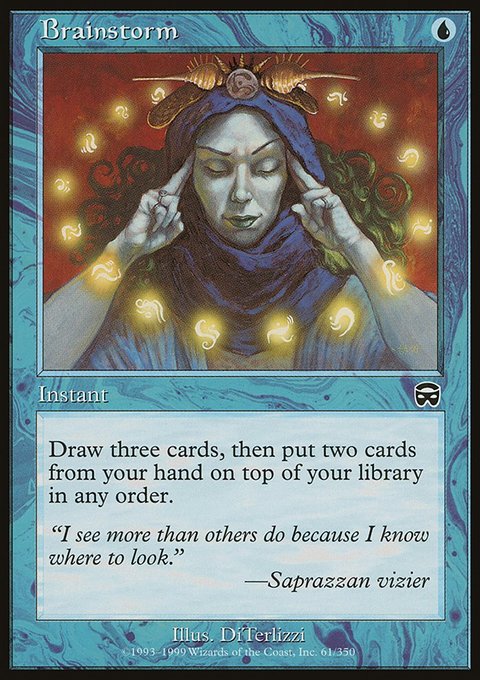

DDFT
I would expect a modern DDFT list to run the default 8 of Ponder x Brainstorm and anywhere between 2 and 4 copies of Preordain. I would also not be surprised to expect maybe 0-2 Street Wraith. If Astrolabe is to be run, it would likely take the Preordain slot as the deck needs room for its fast mana. As a general rule of thumb, the less preordain you have, the fast you intend the deck to be.
DDEFT
DDEFT would be also wanting to run the 8 plus 2-4 Preordain. Unlike DDFT however it cannot afford to run either cycling effects like Street Wraith, nor can it run Arcum's Astrolabe. With Experimental Frenzy out you cannot easily cast either card from the top of your deck thus increasing the liklihood of whiffing whilst with a Frenzy out. This shouldn't matter however as a Frenzy can itself generate such a high potential card advantage that having less cantrips is considered fine.
Meandeck
Meandeck probably wants the highest number of cantrips of any of the variants. It looks to play a longer game which means trying to hit land drops most consistently along with finding the normal combo elements. Meandeck should run the standard 8 plus 3-4 Preordain. Unlike DDFT any Astrolabe being run would be in addition to Preordains, not instead of. The lists also run between 1-2 Street Wraith and 1-2 Edge of Autumn.
Protection
No combo deck wants to run into potential permission without first having some sort of guard up (except maybe Belcher). Interaction is part of what makes Legacy so much fun and having tools to interact with your opponent proactively, or to react to their interaction is crucial. This section touches somewhat upon the later discussion of splash colours but hopefully will keep it to a simple numbers game for now.
Interaction can come in many forms such as proactive discard effects like Duress and Thoughtseize, reactive cards like Force of Will and Flusterstorm, cards that can perform both roles to an extent like Orim's Chant and Veil of Summer or static abilities such as Defense Grid and Teferi, Time Raveler. Depending on the list you are running these are all options available to a Doomsday pilot. Normally you would want at least 8 pieces of protection maindeck with additional sideboard slots dedicated to more specific interaction.
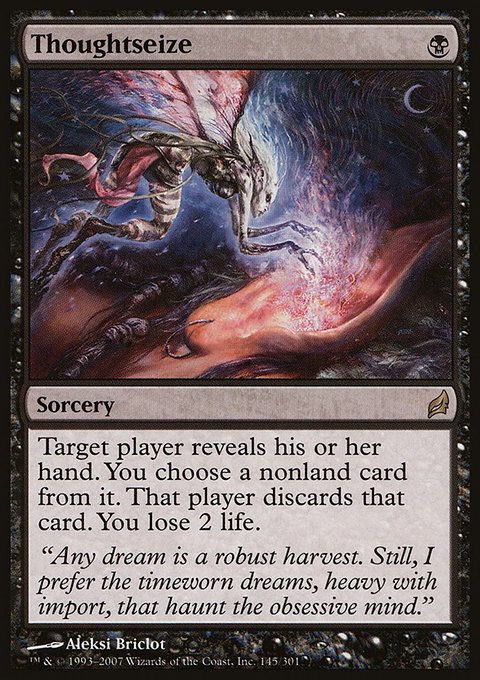
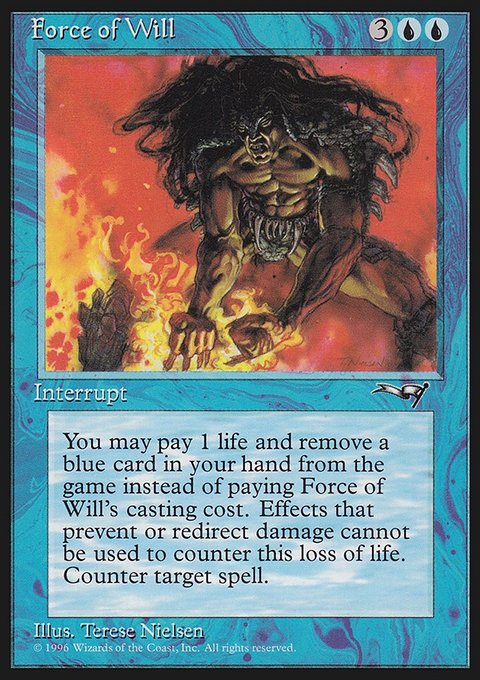
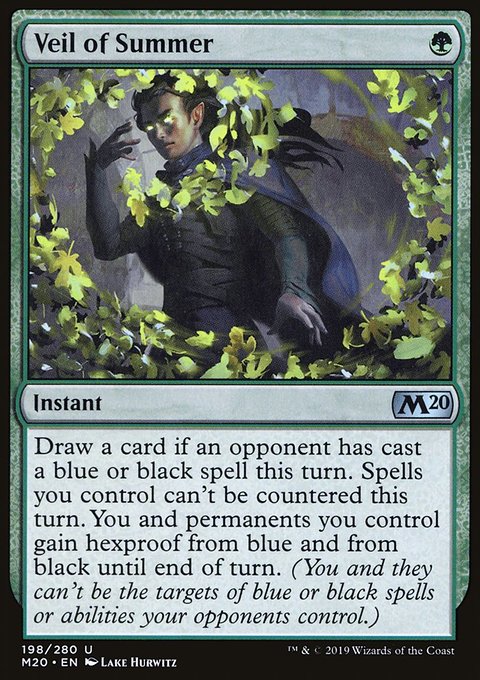
DDFT
DDFT tends to run around 7-8 protection slots main. The lists that run 7 often run an additional piece of discard in the sideboard that can be found with Burning Wish thereby adding a pseudo additional 4 pieces of discard to that count. This is normally a split of Thoughtseize and Veil of Summer or Thoughtseize and Duress in the main with the sideboard option being Duress or Cabal Therapy. Countermagic is not used in these lists except as a sideboard slot against other fast combo decks as it interacts poorly with the card Lion's Eye Diamond. also tends to not be run as it has limited beneficial options for the deck so cards like Silence are less likely to be seen.
DDEFT
DDEFT tends to skimp a little bit on protection. Normally only 6-7 pieces of protection main. These also should always be proactive pieces. If Experimental Frenzy is on the field and you hit a counterspell on top you are then stuck with it present on the top of your deck or, in hand where it cannot be cast at all. Thoughtseize and Duress are the favourites over other splash options like Veil of Summer as trying to balance mana when playing off the top of your deck can really put a strain on having the right colours and you always want in abundance.
Meandeck
Meandeck probably has the most dedicated protection slots and the widest range of available protection/permission to it. It tends to always run at minimum 4 Force of Will and that is supported by another 7-8 protection slots. These can be, depending on the splash colours run, any ratio of discard, veils, chant effects, soft counters or similar and sometimes include pieces of maindeck removal like Abrupt Decay too.
Combo Pieces
Although the deck is normally a one card combo there are certain other pieces needed to make it work it the most efficient way possible. These are often cards that may have limited usefulness outside of winning the game. Normally decks have 1-2 raw card advantage engine pieces Ideas Unbound, Act on Impulse or Predict to enable drawing into the Doomsday pile. In addition some number of cards (0-4) to facilitate getting through the piles easier like Echo of Eons, Street Wraith or Edge of Autumn are run to make it more mana efficient to get the win.
Lion's Eye Diamond falls into this category. Although it can be used to provide a mana boost when digging into a Doomsday pile or used to cast something grabbed with Burning Wish, it generally just sits pretty doing nothing prior to that. It is however one of the most powerful tools when performing the combo and thus should always be run, albeit to varying degrees. In storm builds it provides free storm and can enable the easy casting of Echo of Eons.
Finally some sort of win condition is required. This can be in the form of Tendrils of Agony, Thassa's Oracle or even Collective Brutality. Burning Wish can also take this spot as it can tutor up a Tendrils if needed. You want to run as few dead cards as possibly and generally the win condition is counted as such so you only want 1-2 of them.
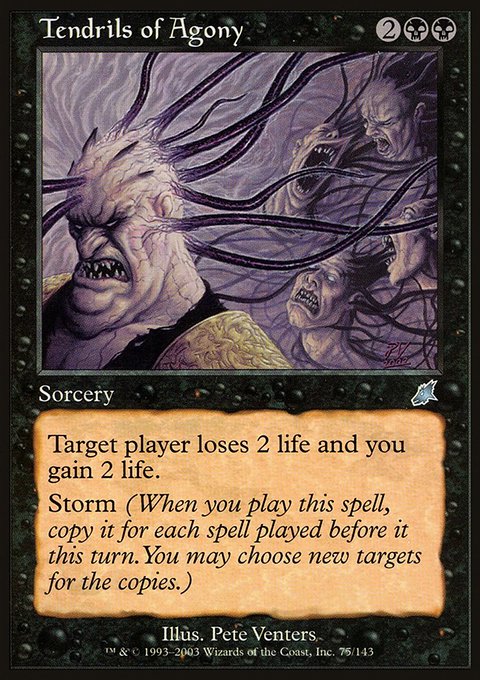


DDFT
DDFT tends to run 1 card advantage spell and this is normally Ideas Unbound or Cruel Bargain. It can also then run either 0-2 Cycle effects and 0-3 Echo of Eons with a potential 4th as a wish target in the sideboard. Generally the win conditions are 0-1 Tendrils main (0 if the Tendrils is wishable from the side) and 1 Oracle main. Tendrils is retained as it takes the requirement to have Doomsday resolve out by giving the option to win from just a natural storm-style kill. DDFT lists should run 4 Lion's Eye Diamonds as they have a lot of utility.
DDEFT
DDEFT doesn't need to run a card advantage spell thanks to Experimental Frenzy however it can elect to run 0-1 Act on Impulse. Spells that actually draw cards can be a liability as, with Frenzy out, you will not be able to cast them however you can still cast cards that have been exiled. This then rules out the use of Echo of Eons and, as mentioned previously, this also prevents the effective use of cyclers. DDEFT should also run the full 4 Lion's Eye Diamonds. Being able to pay for gain , or and draw a card, all the while effectively ignoring the downside makes it an even more powerful card than in other lists.
Meandeck
Meandeck lists are more prone to passing the turn and playing more reactive protection so the downside of Lion's Eye Diamond is more significant. Despite this, it still enables some of the more mana efficient wins and so generally 1 is run. Meandeck lists tend to be able to run the more mana efficient card advantage engines too so run 1-2 Predict or Ideas Unbound. They tend to run between 1-2 Street Wraith and 1 Edge of Autumn. Edge is crucial as it provides a life-free alternative to drawing one card deeper into the Doomsday pile. Finally the win condition is 1-2 Thassa's Oracles. Often it is run as a singleton main with an additional copy in the sideboard.
Manabase
Being a combo deck, Doomsday does not need to run as many lands as some of it's fairer cousins. Depending on how fast you intend to try and win and how much other mana acceleration you are playing a deck should run typically 15-18 lands, usually around 16/17. This tends to be mostly comprised of a minimum of 4 Polluted Delta, 4 other on-colour fetchlands or 4 Prismatic Vista, at least 1 Island / Snow-Covered Island and 1 Swamp / Snow-Covered Swamp and 1 Underground Sea. The rest is the a mix of additional Seas, some other U/X and B/X splash duals and additional basic lands as required. Astrolabe decks tend to run more basics compared to their non-snow cousins. Even with Astrolabes, you should consider at least 2 Underground Seas in your list and probably 1 each of the primary splash colour U/X and B/X dual land.
For example if you are running a Grixis list you should run 1 Volcanic Island and 1 Badlands and tailor your fetchlands accordingly so 4 Delta and 4 Scalding Tarn or 3 Tarn and 1 Bloodstained Mire. Being able to fetch a basic Island is more crucial than a basic swamp as that tends to allow you to get into the game in the first place and the majority of your deck is based cantrips anyways.
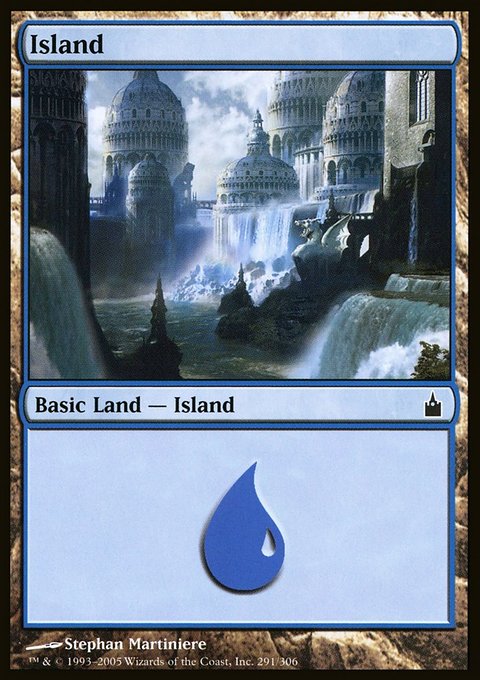
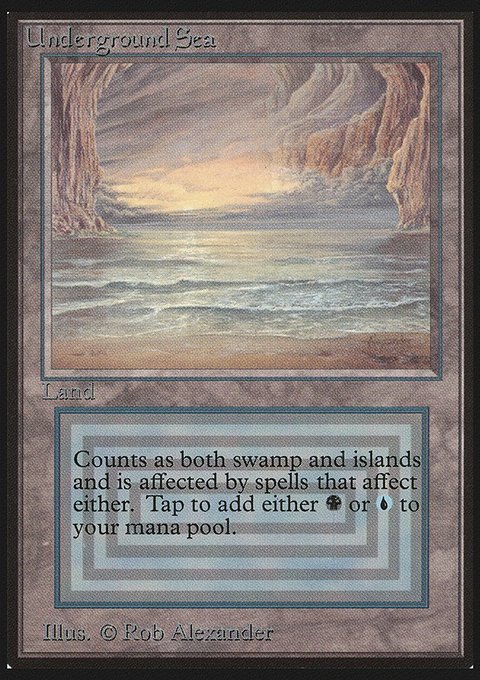
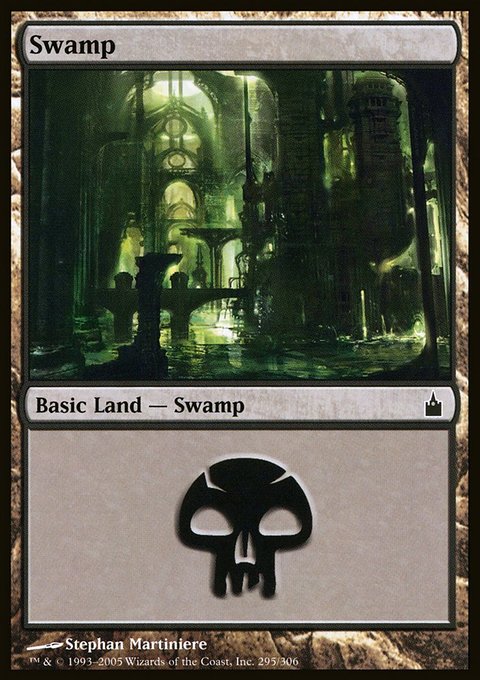
DDFT and DDEFT
As these are more speed oriented lists they tend to stay at the 15-17 land range. This is normally 4 Delta, 4 Tarn or 3 Tarn/1 Mire, 1 Volcanic Island, 1 Badlands, 2 Underground Seas, 2 Islands and 1 Swamp. Sometimes (if there is a splash colour) you might add an additional land or replace the second basic Island with a, in the example of , Bayou and/or Tropical Island. Toolbox lands such as Nurturing Peatland tend not be be used for these lists but can be an option.
Meandeck
As the more control oriented lists, Meandeck decks tend to go around the 17-18 land mark. This tends to be 4 Delta, 4 Splash Fetch (Misty Rainforest for BUG and Flooded Strand for Esper) or 4 Prismatic Vista, 1-3 Underground Seas, 1 of each splash dual (so for 1 Tundra and 1 Scrubland) and 2-5 basic lands. Normally 1-4 Islands, 1-2 Swamps, and 0-1 Splash Basic. Some pilots also elect to run a toolbox land such as a Cavern of Souls, Mystic Sanctuary or Silent Clearing.
Sideboard
Across all the variants and pilots the styles of sideboards can vary dramatically. Some tailor completely to facing other matchups, some include some sort of secondary or tertiary win condition and those with Burning Wish can even include a tutorable toolbox that can deployed to the main deck game plan.
As any Legacy player knows, mapping sideboards or listing sideboard options can be an incredibly lengthy process that changes based on meta, collated results and gut feelings. As a result going into it fully now would be rushing it and it likely deserves a piece all to itself. As a result I will not be discussing sideboards fully here however some options will be explored in the next section.
Colour Choices
Doomsday decks have some interesting choices when it comes to what colours to run within them. Doomsday itself is a card costing so that immediately locks in one of your colours. Almost all lists (as discussed above) feature cantrip shells so the decks are often solidly based in however the rest of the available colours are all useable within the shell. Below will be a summary of each variant and the colour options they tend to run followed by some in depth discussion as to what the different colour splashes bring to the table in terms of tools.
DDFT Normally base with the option to splash or .
DDEFT Normally base , unlikely to run splash colours.
Meandeck Normally or with the option to splash ,
or .
White
White is almost exclusively played in Meandeck lists however you could easily incorporate it into DDFT. Maindeck, provides protection spells mostly in the form of Orim's Chant, Silence or Teferi, Time Raveler the last of which can also act as a method to draw into a Doomsday pile or a mini card advantage engine when the -3 is coupled with Arcum's Astrolabe. Abeyance is another great option that also cantrips and so makes a good initiation spell for drawing into a Doomsday pile.
From the sideboard offers a plan B in the form of Monastery Mentor that plays well with the cantrip dense lists that are run. Removal comes in the form of Disenchant or Wear//Tear for artifact or enchantment hate and Swords to Plowshares to deal with problematic creatures. You also gain some additional graveyard hate options in the form of Rest in Peace.
Teferi and Mentor are probably the biggest boons for playing .
Red
Red is obviously a staple for DDEFT and often for DDFT too. It enables Burning Wish in the main deck as a tutor for both the combo elements and other toolbox cards. From the side it can provide access to alternative win conditions like Empty the Warrens and a plethora of removal for different scenarios such as Abrade, By Force or Rending Volley to name a few. also gives you access to Pyroblast / Red Elemental Blast effects which are incredibly powerful tools against any based matchup.
Empty the Warrens and Red Blasts are the biggest boons for playing .
Green
Green provides a slightly cheaper package in terms of mana cost. Maindeck it provides access to protection in the form of Veil of Summer and super efficient removal in the form of Abrupt Decay. From the sideboard additional Veils/Decays may be brought in alongside other elements such as Carpet of Flowers or Xantid Swarms. does not have a plan B associated with it however some have explored the use of Oko, Thief of Crowns as a potential option or Uro, Titan of Nature's Wrath.
Veil and Decay are the biggest boons for playing .
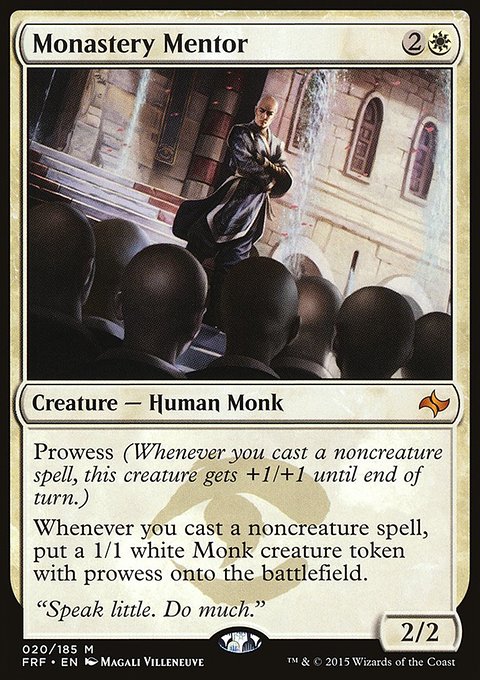
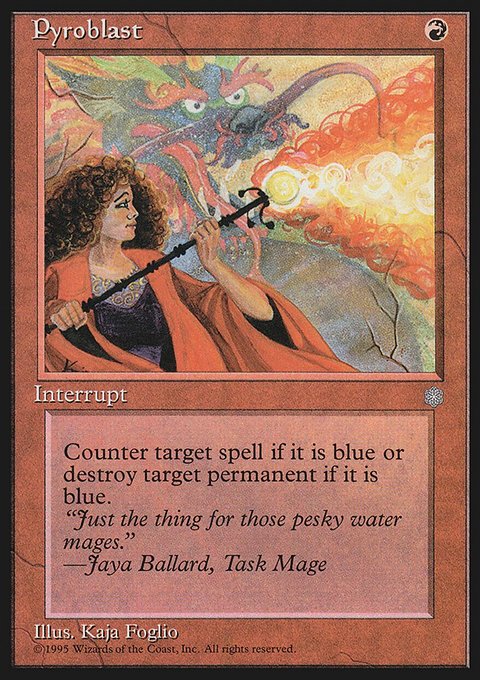

No Splash
There is some potential for running a straight list with no splash colours. For a speed focused list, use of Wishclaw Talisman and Echo of Eons could allow for a fast win however they may be considered unreliable. Your protection suite is also limited to countermagic and discard (both matching poorly against opposing Veil effects) and either based creature removal or based bounce removal which is not permanent.
There is some scope for a plan B with the use of creatures like Snapcaster Mage, Dark Confidant or Rotting Regisaur however these are not the most powerful of tools. Of the plan B options available, Divining Witch is certainly the most effective providing a 1 card combo engine that enables you to both find Thassa's Oracle and exile your library with the Oracle trigger on the stack all the while avoiding cards like Spell Pierce, Force of Negation and Flusterstorm.
Budget and consistent mana is the biggest boon for playing straight .
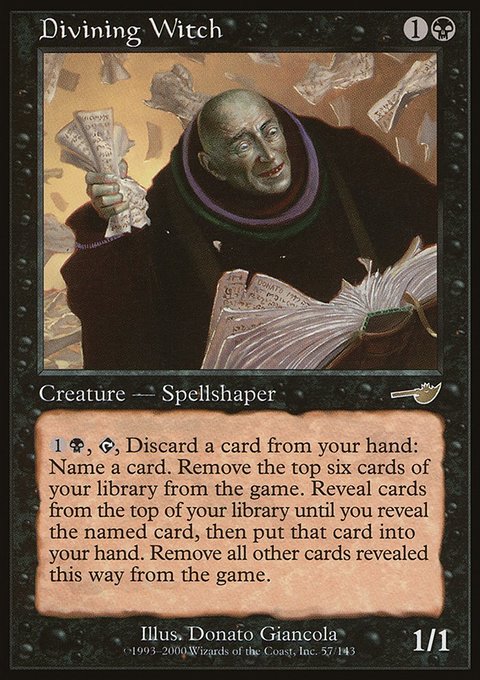
The Mechanics of Resolving Doomsday
We will now move away from the construction of the deck and have a quick look at the mechanical elements required to actually resolve the card Doomsday. This may sound silly but I remember, when learning, that this was one aspect I messed up on a number of times (as a paper only player) and it was only later into my Legacy 'career' I felt comfortable with it.
A large part of the confusion for the physical resolution of it stems from the wording on the original Weatherlight printing of Doomsday. See the card below along with the original rules text printed:

Pay half your life, rounded up:
Put your graveyard on top of your library, then remove all but five cards of your library from the game.
Put the rest on top of your library in any order.
With this older templating there are a number of pitfalls that can snag the
unwary who have not read up on the updated Oracle text. First of all the "Pay
half your life, rounded up" is not a cost as is implied by the colon : but
actually part of the resolution. You will not lose your life for putting
Doomsday on the stack! Despite what the colon present may imply, the resolution
of the card is not an activated ability. I have had an opponent before who
read my card and asked a nearby judge "can I name this card with Pithing
Needle" to which the judge quite correctly replied: "Yes". My opponent then
proceeded to play said Pithing Needle on the card and was quite put out
that it did not work the way they had hoped it would.
Before the next point let's take a look at the updated Oracle wording on the A25 Doomsday:
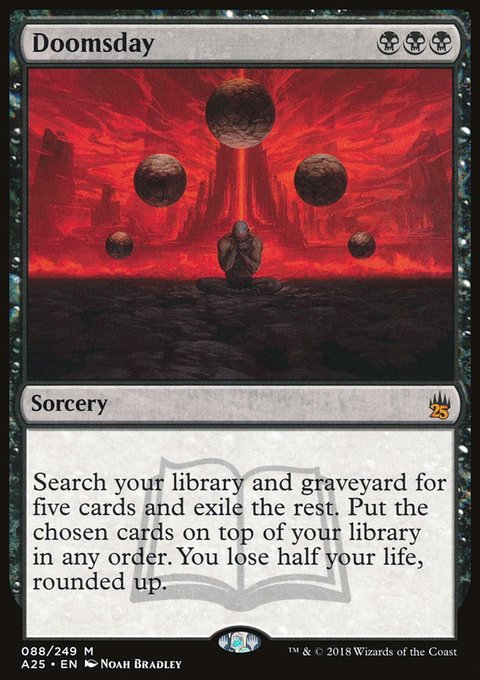
Search your library and graveyard for five cards and exile the rest.
Put the chosen cards on top of your library in any order.
You lose half your life, rounded up.
As you can see the wording changes significantly. If you were to perform the actions specified by the original wording and shuffled your graveyard and library together you can be called out for a GRV at competitive REL so watch out. Cards like Shadow of Doubt will work in preventing you from searching your library for cards but will still allow you to search your graveyard. One especially key thing to note is your opponent is allowed to see what cards you select (if any) from the graveyard as it is an open information zone. You are not required to explicitly state what you are taking however you should always allow them time to ask to see what cards are chosen and are not allowed to hide that information from them.
The last point I want to make on resolving Doomsday is one about time. On MTGO you have a chess clock that allows you to take much longer on decisions however in paper there is no such mechanic. As a result I would always advise you know what pile you are going to make before even considering to put Doomsday on the stack. This will save you a lot of time and your opponent's will thank you for it. As Doomsday is (or possibly was) quite a niche deck, a lot of people offline would generally give a generous allowance during the resolution of Doomsday to work out the pile you will build however this cannot be relied on, especially with the deck becoming less and less rogue. Even online you could find yourself eating at your clock a bit too much which may result in losses across grindier matches if you're not careful.
The use of pencil and notepad during paper games or just notepad.exe on the computer is a great way to map out your pile and note mana/draw constraints whilst planning it. You should also goldfish, goldfish, goldfish! The deck is unforgiving to mistakes, especially when made after Doomsday has resolved. Forgetting the order of cards when naming with Predict, failing to activate a Lion's Eye Diamond at the right time or even forgetting to include a win condition in your pile are all things that can happen!
As a way to minimise your own mistakes potential, just practice playing some hands, build the piles. Even if they seem super simple it is important to get the basics down first. Once you have done that you can start to train yourself on some puzzles or at least have the confidence to face interaction without worrying about becoming your own enemy.
Learning Piles
There is one final point I wish to touch on which is learning Doomsday piles (sometimes referred to as stacks). The first questions that people tend to ask other than "what is the currently played standard list?" is often "what are the basic piles?". The key mechanics are explained here on the Wiki already and my last article went over some of them briefly but people then ask for more. One question that is asked is "can I get a list of piles please?
Back in the days of the Stormboards there was a pile document maintained that tried to list every conceivable Doomsday pile, the card requirements, mana requirements and storm requirements however this led to people relying on it. If they had failed to rote memorise a pile they would panic and get confused.
A better approach is to learn the general rules or theories behind cards and then apply them to a scenario. Out of all the variants DDEFT probably has the smallest pool of potential piles and Meandeck the largest however 80-90% of the time you will only be using a small selection.
If in doubt, practice makes perfect! 100 games trying to build and construct piles on the fly are much better than trying to memorise 100 potential piles by rote.
Until next time.
May you avoid the first horsemen of the apocalypse!
(Stay safe and be kind to one another).
Post Script Puzzle
d8dk32 recently forwarded me a tweet by Stephen Menendian (designer of the 2012 iteration of Meandeck Doomsday) who posted this picture as a turn 1 win in Vintage. It is in fact also a deterministic turn 1 kill in Legacy Doomsday too!
https://twitter.com/SMenendian/status/1242650950415691776
Have a go at working out this little puzzle checking the meandeck lists on the Wiki and see if you can work it out :)
For more content, please check out our resources page which includes a list of community streamers. If you would like to submit content to the Wiki, feel free to reach to us in the Doomsday Discord.